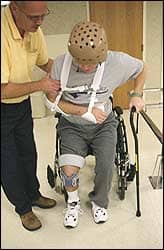A study by researchers from National Taiwan University and Taipei Hospital on the rehabilitation of stroke patients has found that combining robot-assisted therapy with functional task training improves use of both arms in daily life.
Robotic rehabilitation holds promise for enhancing traditional post-stroke interventions as robots can provide massive and intensive training in a consistent manner without fatigue, with programming precisely tailored to each patient′s needs. The rehab robots give sensorimotor feedback via visual and auditory feedback during training sessions.
Stroke patients′ arm motor function and muscle strength have been shown to improve during robot-assisted therapy in rehabilitation. Previous studies, however, have suggested that these improvements did not carry through to the patients′ daily lives.
In the study, researchers included real-world arm activity by having patients wear accelerometers on both arms as they went about their normal tasks at home. This gave the accurate information needed to verify the intensity and amount of physical activity the patients actually do in real-life situations and tailor the training given to both arms for each patient.
“In this study of rehabilitation approaches for patients with mild-to-moderate upper limb impairment six months after a stroke, we found significantly greater benefits of robot-assisted therapy compared with the active control group on the amount and quality of functional arm activity for the hemiplegic hand in the living environment," said Keh-chung Lin of National Taiwan University. "Moreover, robot-assisted therapy had superior benefits on improving bimanual arm activity."
"Effects of robot-assisted upper limb rehabilitation on daily function and real-world arm activity in patients with chronic stroke: a randomised controlled trial" was published in the journal Clinical Rehabilitation.
[Source: British Journal of Healthcare Computing]




